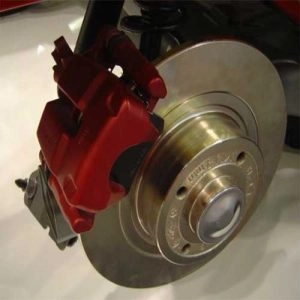The braking system in a car is considered one of the essential parts that must exist for the vehicle to function properly and avoid dangerous accidents. This system contributes to slowing down and stopping the car. It's important that the brake force is appropriate, neither too weak nor excessively strong. Very powerful brakes can potentially harm passengers and expose them to injury if suddenly employed. This is because the car stops forcefully and without any prior warning, causing the rear passenger to violently collide with the back of the front seat and the driver to crash into the steering wheel.
The effectiveness of brakes is linked to Newton's laws of motion, which state that a body at rest or in motion will remain so unless acted upon by an external force. If a car's braking system is very weak, the stopping distance of the car will increase, thereby increasing the likelihood of serious accidents in some instances. Therefore, the car's braking system must work perfectly to stop the car as quickly as possible and at a safer distance, without causing harm or extreme panic to the driver or passengers.

To reach the desired level of brake performance, the technology of the brake system in cars has been significantly developed, starting from mechanical brakes to pneumatic and hydraulic brakes, and finally to electric car brakes. In this article, we will primarily talk about the types of car brakes, and the features of each, so stay with us.
What are the types of car brakes?
There are five main brake systems in cars, which are:
The car's mechanical brake system:This system relies on the use of a handbrake, which is found in cars that utilize this concept either as a pedal located next to the brake pedal, or a lever near the driver's seat, connected to steel wires that extend to the brake components located in the rear of the car. The braking force and deceleration rate vary according to surface friction and the applied operational force.
This system has several features; it is a simple concept, and it is easy to maintain at a service center or by a specialized technician. It is also less expensive than the hydraulic brake system which we will discuss shortly, and it adds several functions to the emergency brakes.

The hydraulic brake system of the car:It is used in the hydraulic fluid system to transmit pressure from the brake pedal to the rear and front pads to slow down and stop the car. The pedal works to transfer the effort of the driver's foot to the master cylinder piston, leading to the pressurization of the brake oil, and thus its transfer to the front and rear calipers, completing the braking process.
This system is characterized by providing the same results with relatively less braking effort, as it distributes the braking force among all tires. It is considered more efficient than the mechanical brake system, and it suits all cars with independent suspension.
Also read:5 Signs Indicating Oil Siphon Damage
The vehicle's air brake system:Also referred to as the air brake system, it consists of several parts and components, such as the auxiliary air tank, air compressor, safety valves, check valves, and so on. Functionally and operationally, it greatly resembles the hydraulic brake system, the fundamental difference being that the mechanical force is transferred to the car's tires through air pressure, rather than fluid pressure. Manufacturing experts recommend using this type of brake in heavy vehicles, like transport trucks for example.
This system stands out for being extremely robust. You can operate it smoothly and have complete control over everything. It is less prone to errors, making it more reliable than hydraulic brakes. It's also environmentally friendly because the air used to transmit mechanical force comes directly from the surrounding atmosphere. Lastly, if a leak occurs in this system, it will be less than the leakage that occurs in the hydraulic brake system.

Electromagnetic Braking System:It relies on the principle of achieving braking without friction, which ensures increased brake efficiency and a longer lifespan. This principle also eliminates the need for oil and prevents friction, which can sometimes lead to issues. This system is used in modern and hybrid cars as the brakes are medium-sized, not like regular brakes. It is also used in railway tracks.
The mechanism of this system relies on passing a magnetic field perpendicularly to the rotation direction of a wheel. This induces a quick magnetic current in the opposite direction to the wheel's rotation, creating a counter-rotational force, which in turn slows down the speed. This system is characterized by the fact that it does not require regular maintenance, and the brakes are less expensive and faster. It generates less heat than a mechanical braking system.
The car's brakes are an electric braking system.It is commonly used in electric cars, where braking is applied by electric motors. This system is safe and smooth, greatly aids in energy conservation, and can increase the system speed when transporting heavy loads. It does not require frequent replacement and maintenance like the mechanical braking system.
Finally, the importance of maintenance work is crucial.Car BrakesA special and intelligent mechanism, which is difficult to understand for many, it generally depends on the friction that converts the kinetic energy of the car into heat, and relies on the transmission of mechanical force.

Comments